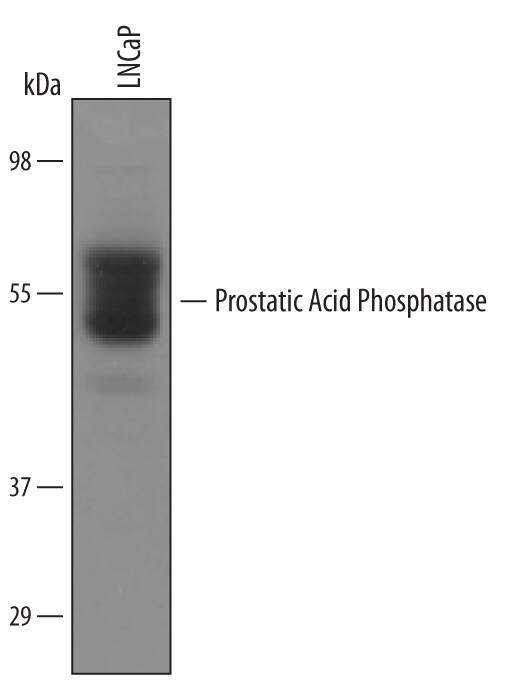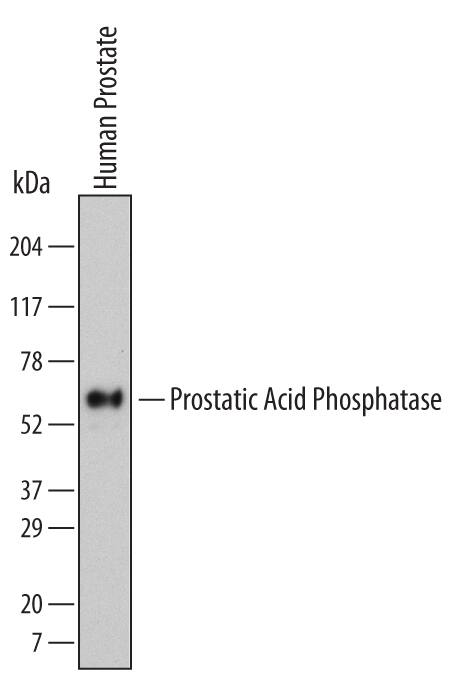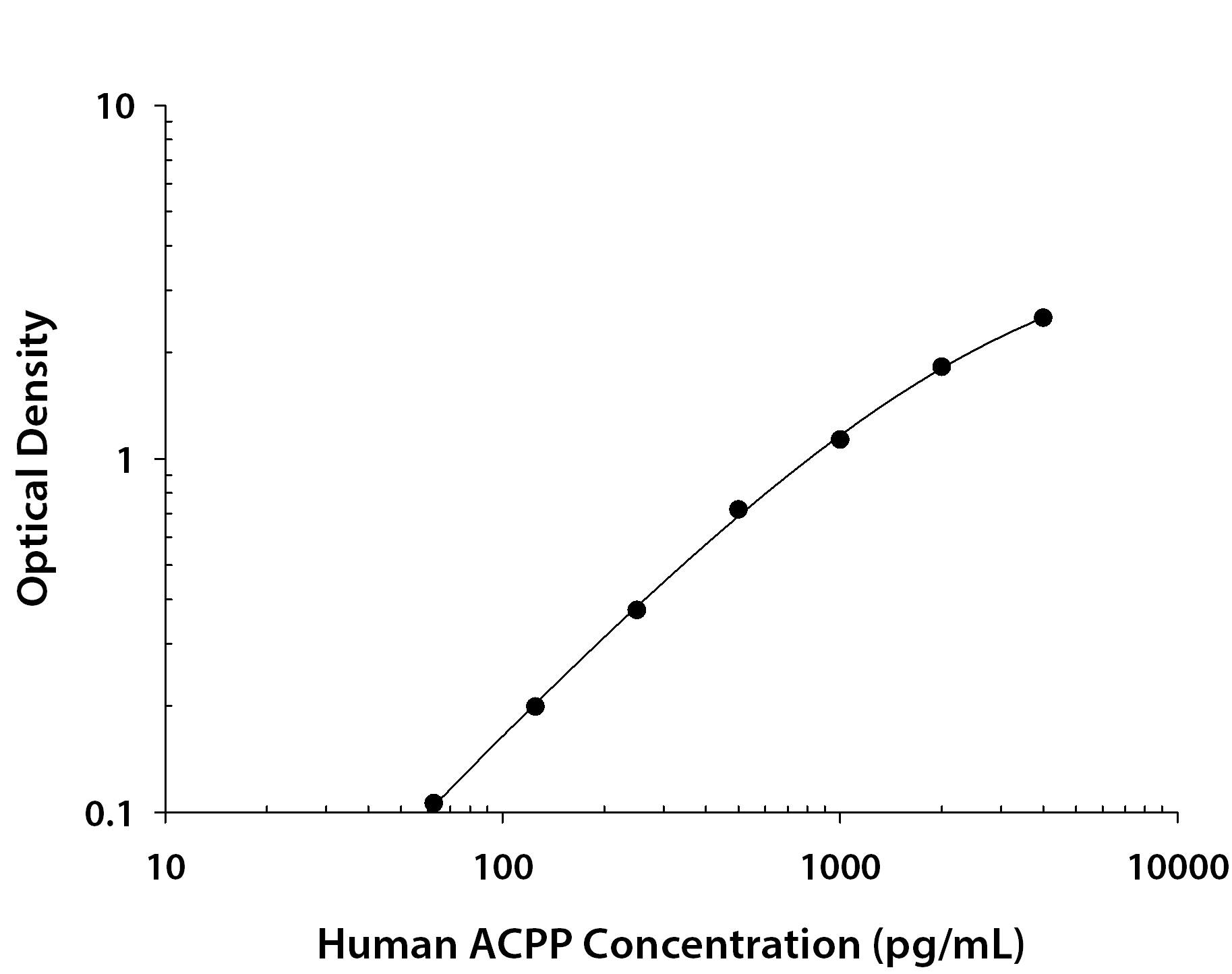Prostatic Acid Phosphatase/ACPP Products
ACPP (Acid phosphatase, prostate; also PAP and ACP3) is a 48-52 kDa glycoprotein member of the histidine acid phosphatase family of enzymes. It exists as a 95-100 kDa nondisulfide-linked homodimer that hydrolyzes phosphate esters under low pH to generate free phosphate. ACPP is expressed by prostate epithelium and pain-detecting spinal cord neurons. In the spinal cord, ACPP dephosphorylates AMP. This generates adenosine which acts as a strong analgesic agent.
Mature human ACPP is 354 amino acids (aa) in length (aa 33-386). It contains one histidine phosphatase domain (aa 34-332), plus a nucleophile acceptor site at His44, and a proton donor site at Asp290. There are two potential alternative splice variants. One shows a deletion of aa 153-185, while another is transmembrane (previously called TMPase) and shows a 38 aa substitution for the C-terminal seven amino acids. Over aa 33-379, human ACPP shares 84% aa identity with mouse ACPP.
Products:
57 results for "Prostatic Acid Phosphatase/ACPP" in Products
57 results for "Prostatic Acid Phosphatase/ACPP" in Products
Prostatic Acid Phosphatase/ACPP Products
ACPP (Acid phosphatase, prostate; also PAP and ACP3) is a 48-52 kDa glycoprotein member of the histidine acid phosphatase family of enzymes. It exists as a 95-100 kDa nondisulfide-linked homodimer that hydrolyzes phosphate esters under low pH to generate free phosphate. ACPP is expressed by prostate epithelium and pain-detecting spinal cord neurons. In the spinal cord, ACPP dephosphorylates AMP. This generates adenosine which acts as a strong analgesic agent.
Mature human ACPP is 354 amino acids (aa) in length (aa 33-386). It contains one histidine phosphatase domain (aa 34-332), plus a nucleophile acceptor site at His44, and a proton donor site at Asp290. There are two potential alternative splice variants. One shows a deletion of aa 153-185, while another is transmembrane (previously called TMPase) and shows a 38 aa substitution for the C-terminal seven amino acids. Over aa 33-379, human ACPP shares 84% aa identity with mouse ACPP.
Products:
Recombinant Monoclonal Antibody
| Reactivity: | Human |
| Details: | Rabbit IgG Kappa Monoclonal Clone #ACPP/4495R |
| Applications: | IHC |
| Reactivity: | Human |
| Details: | Mouse IgG1 kappa Monoclonal Clone #ACPP/1338 |
| Applications: | IHC |
Recombinant Monoclonal Antibody
| Reactivity: | Human |
| Details: | Rabbit IgG Kappa Monoclonal Clone #ACPP/8409R |
| Applications: | IHC |
Recombinant Monoclonal Antibody
| Reactivity: | Human |
| Details: | Mouse IgG1 kappa Monoclonal Clone #rACPP/1338 |
| Applications: | IHC, MA |
Recombinant Monoclonal Antibody
| Reactivity: | Human |
| Details: | Rabbit IgG Kappa Monoclonal Clone #ACPP/4495R |
| Applications: | IHC |
Recombinant Monoclonal Antibody
| Reactivity: | Human |
| Details: | Rabbit IgG Kappa Monoclonal Clone #ACPP/8409R |
| Applications: | IHC |
Recombinant Monoclonal Antibody
| Reactivity: | Human |
| Details: | Rabbit IgG Kappa Monoclonal Clone #ACPP/8409R |
| Applications: | IHC |
Recombinant Monoclonal Antibody
| Reactivity: | Human |
| Details: | Rabbit IgG Kappa Monoclonal Clone #ACPP/4495R |
| Applications: | IHC |
Recombinant Monoclonal Antibody
| Reactivity: | Human |
| Details: | Rabbit IgG Kappa Monoclonal Clone #ACPP/8409R |
| Applications: | IHC |
Recombinant Monoclonal Antibody
| Reactivity: | Human |
| Details: | Mouse IgG1 kappa Monoclonal Clone #rACPP/1338 |
| Applications: | IHC, MA |
Recombinant Monoclonal Antibody
| Reactivity: | Human |
| Details: | Mouse IgG1 kappa Monoclonal Clone #rACPP/1338 |
| Applications: | IHC, MA |
| Reactivity: | Human |
| Details: | Sheep IgG Polyclonal |
| Applications: | WB, ELISA, IHC |
| Reactivity: | Human |
| Details: | Mouse IgG1 Monoclonal Clone #690017 |
| Applications: | WB, IHC |
Recombinant Monoclonal Antibody
| Reactivity: | Human |
| Details: | Mouse IgG1 Monoclonal Clone #911603R |
| Applications: | ELISA |
| Assay Range: | 62.5 - 4,000 pg/mL |
| Applications: | ELISA |
| Source: | NS0 |
| Accession #: | P15309 |
| Applications: | EnzAct |
| Reactivity: | Human |
| Details: | Rabbit IgG Polyclonal |
| Applications: | IHC, WB |
| Reactivity: | Human |
| Details: | Mouse IgG1 kappa Monoclonal Clone #SPM312 |
| Applications: | IHC, ICC/IF, Flow |
| Reactivity: | Human |
| Details: | Rabbit IgG Polyclonal |
| Applications: | IHC |
| Reactivity: | Human, Mouse |
| Details: | Goat IgG Polyclonal |
| Applications: | IHC, WB, ELISA |
| Reactivity: | Human |
| Details: | Goat IgG Polyclonal |
| Applications: | IHC, WB, ELISA |
| Applications: | AC |
| Applications: | ELISA |
| Reactivity: | Human |
| Details: | Mouse IgG1 kappa Monoclonal Clone #SPM312 |
| Applications: | IHC, ICC/IF, Flow, CyTOF-ready |
Recombinant Monoclonal Antibody
| Reactivity: | Human |
| Details: | Rabbit IgG Kappa Monoclonal Clone #ACPP/8409R |
| Applications: | IHC |


![Immunohistochemistry-Paraffin: Prostatic Acid Phosphatase/ACPP Antibody (ACPP/1338) [NBP2-47631] Immunohistochemistry-Paraffin: Prostatic Acid Phosphatase/ACPP Antibody (ACPP/1338) [NBP2-47631]](https://resources.bio-techne.com/images/products/Prostatic-Acid-Phosphatase-ACPP-Antibody-ACPP-1338-Immunohistochemistry-Paraffin-NBP2-47631-img0001.jpg)








![Western Blot: Prostatic Acid Phosphatase/ACPP Antibody [NBP2-39012] Western Blot: Prostatic Acid Phosphatase/ACPP Antibody [NBP2-39012]](https://resources.bio-techne.com/images/products/Prostatic-Acid-Phosphatase-ACPP-Antibody-Western-Blot-NBP2-39012-img0002.jpg)
![Immunohistochemistry-Paraffin: Prostatic Acid Phosphatase/ACPP Antibody (SPM312) [NBP2-53169] Immunohistochemistry-Paraffin: Prostatic Acid Phosphatase/ACPP Antibody (SPM312) [NBP2-53169]](https://resources.bio-techne.com/images/products/Prostatic-Acid-Phosphatase-ACPP-Antibody-SPM312-Immunohistochemistry-Paraffin-NBP2-53169-img0003.jpg)
![Immunohistochemistry-Paraffin: Prostatic Acid Phosphatase/ACPP Antibody [NBP1-90263] Immunohistochemistry-Paraffin: Prostatic Acid Phosphatase/ACPP Antibody [NBP1-90263]](https://resources.bio-techne.com/images/products/Prostatic-Acid-Phosphatase-ACPP-Antibody-Immunohistochemistry-Paraffin-NBP1-90263-img0005.jpg)
![Western Blot: Prostatic Acid Phosphatase/ACPP Antibody [NBP1-51946] Western Blot: Prostatic Acid Phosphatase/ACPP Antibody [NBP1-51946]](https://resources.bio-techne.com/images/products/Prostatic-Acid-Phosphatase-ACPP-Antibody-Western-Blot-NBP1-51946-img0006.jpg)
![Western Blot: Prostatic Acid Phosphatase/ACPP Antibody [NBP1-78280] Western Blot: Prostatic Acid Phosphatase/ACPP Antibody [NBP1-78280]](https://resources.bio-techne.com/images/products/Prostatic-Acid-Phosphatase-ACPP-Antibody-Western-Blot-NBP1-78280-img0006.jpg)
![ELISA: Human Prostatic Acid Phosphatase/ACPP ELISA Kit (Chemiluminescence) [NBP2-66396] - Human Prostatic Acid Phosphatase/ACPP ELISA Kit (Chemiluminescence)](https://resources.bio-techne.com/images/products/nbp2-66396_human-prostatic-acid-phosphatase-acpp-elisa-kit-chem-13220241622526.jpg)